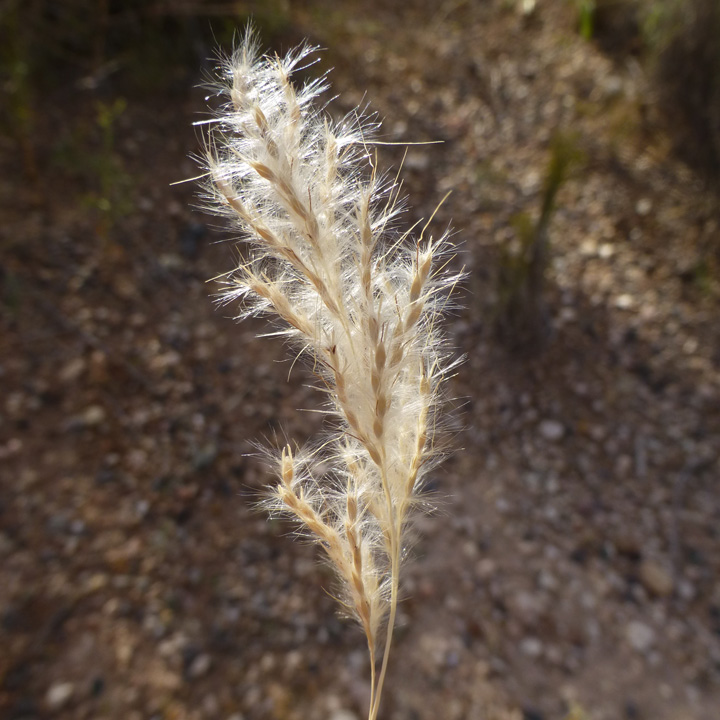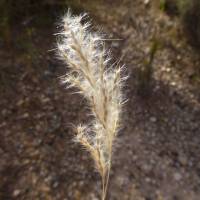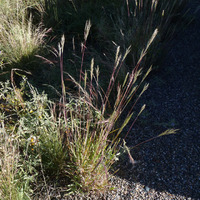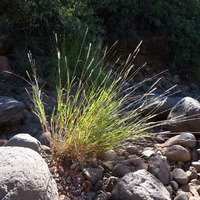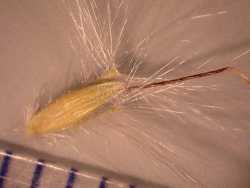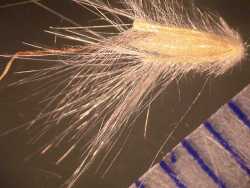Culms 35-115(130) cm tall, usually less than 2 mm thick, erect or geniculate at the base, branched at maturity; nodes shortly hirsute, pilose with erect hairs, or glabrous. Leaves usually basal (sometimes cauline on robust plants), usually glaucous; ligules 1-3 mm; blades 5-25 cm long, 2-7 mm wide, flat to folded, mostly glabrous. Panicles 4-12(14) cm, narrowly oblong or lanceolate, silvery-white or light tan; rachises 4-8 cm, with more than 10 branches; branches 1-5.5 cm, erect-appressed, rarely with axillary pulvini, lower branches shorter than the rachises, usually with more than 1 rame; rame internodes with a groove wider than the margins, margins copiously hairy, hairs 3-9 mm, at least somewhat obscuring the spikelets. Sessile spikelets 2.5-4.5 mm, ovate, somewhat glaucous, apices blunt; lower glumes glabrous or hirtellous, rarely with a dorsal pit; awns 8-16 mm; anthers 0.6-1.4 mm. Pedicellate spikelets 1.5-2.5(3.5) mm, shorter than the sessile spikelets, sterile. 2n = 60.
Bothriochloa laguroides grows in well-drained soils of grasslands, prairies, roadsides, river bottoms, and woodlands, often on limestone, usually at 20-2100 m. Plants from the United States and northern Mexico belong to B. laguroides subsp. torreyana, which differs from B. laguroides subsp. laguroides in its glabrous, or almost glabrous, nodes, long internode hairs, and pilose throat region. Occasional plants are found with spreading branches and axillary pulvini; they do not merit formal recognition. Bothriochloa laguroides subsp. torreyana is used in landscaping. It does well on rocky slopes and sandy banks.
Bothriochloa laguroides has been confused with B. saccharoides (Sw.) Rydb., a more southern species that differs from B. laguroides in having pilose leaves, a narrow central groove in the internodes and pedicels, and panicle branches with axillary pulvini.
Common Name: silver beardgrass
Duration: Perennial
Nativity: Native
Lifeform: Graminoid
General: Perennial bunchgrass, 50-100 cm tall, stems moderately clumped, slender and wiry, erect or geniculate at the base, green to glaucous, glabrous to occasionally short-bearded at the nodes.
Vegetative: Leaves usually basal, cauline on robust plants, glabrous or scabrous, sheaths only slightly keeled, prominently veined; ligule 1-2 mm long, truncate or rounded, lacerate or minutely ciliate on the margin; blades flat or folded, 2-6 mm broad, relatively sh
Inflorescence: Panicle 4-10 cm long, silvery-white or light tan, erect or somewhat spreading; racemose branches 2-4 cm long, few to numerous; rachis of racemose branches and pedicels villous with soft hairs 4-7 mm long, the hair obscuring the spikelets; pediceled spikelet reduced, awnless; sessile spikelet 3-4 mm long; glumes firm but not leathery, glabrous to thinly pubescent, first glumes oblong or lanceolate, flat or nearly so, second glume keeled and v-shaped; fertile lemma bearing a twisted, geniculate awn mostly 10-15 mm long.
Ecology: Found on rocky slopes and sandy plains from 2,000-5,500 ft (610-1676 m); flowers June-October.
Distribution: Southern half of the US, from CA east to GA; south through Greater Antilles, MEX, C. and S. Amer.
Notes: Bothriochloa is a genus of large perennial grasses with distinctive inflorescences of subdigitate (fingerlike) to racemosely arranged branches. Along the inflorescence branches, spikelets are arranged in pairs, one spikelet sessile, fertile, and usually with a geniculate awn from the lemma, and the other spikelet on a pedicel, somewhat reduced, and sterile or staminate. At maturity, the inflorescence breaks into many pieces, with the disarticulation points being along the rame beneath each sessile spikelet. B. laguroides is a large bunchgrass distinguished by its long (ca. 1 cm) geniculate (abruptly bent) awns, copious hairs within the inflorescence that obscure the spikelets and give the inflorescence a silvery look, and slightly pubescent nodes. Similar to B. barbinodis but that species is a less robust plant with smaller spikelets, shorter awns, and an inflorescence which tapers to a narrow apex and has fewer, hairier panicle branches. Specimens in US and n. MEX are B. laguroides subsp. torreyana. Often confused with the similar B. saccharoides; Allred in FNA states that B. saccharoides is more southern (i.e. not in N. America) and thus most material from the US identified as B. saccharoides should probably be annotated as B. laguroides.
Ethnobotany: Unknown
Etymology: Bothriochloa is from the Greek bothros, a pit or hole, and chloe or chloa, grass, alluding to the small pit on the first glume of some species in the genus; laguroides means like the genus Lagurus, a genus of grasses with large plumose flower heads, which in turn derives its name from lagos for a hare and oura for tail.
Synonyms: Bothriochloa saccharoides, Andropogon saccharoides
Editor: SBuckley 2010, FSCoburn 2015, AHazelton 2015


